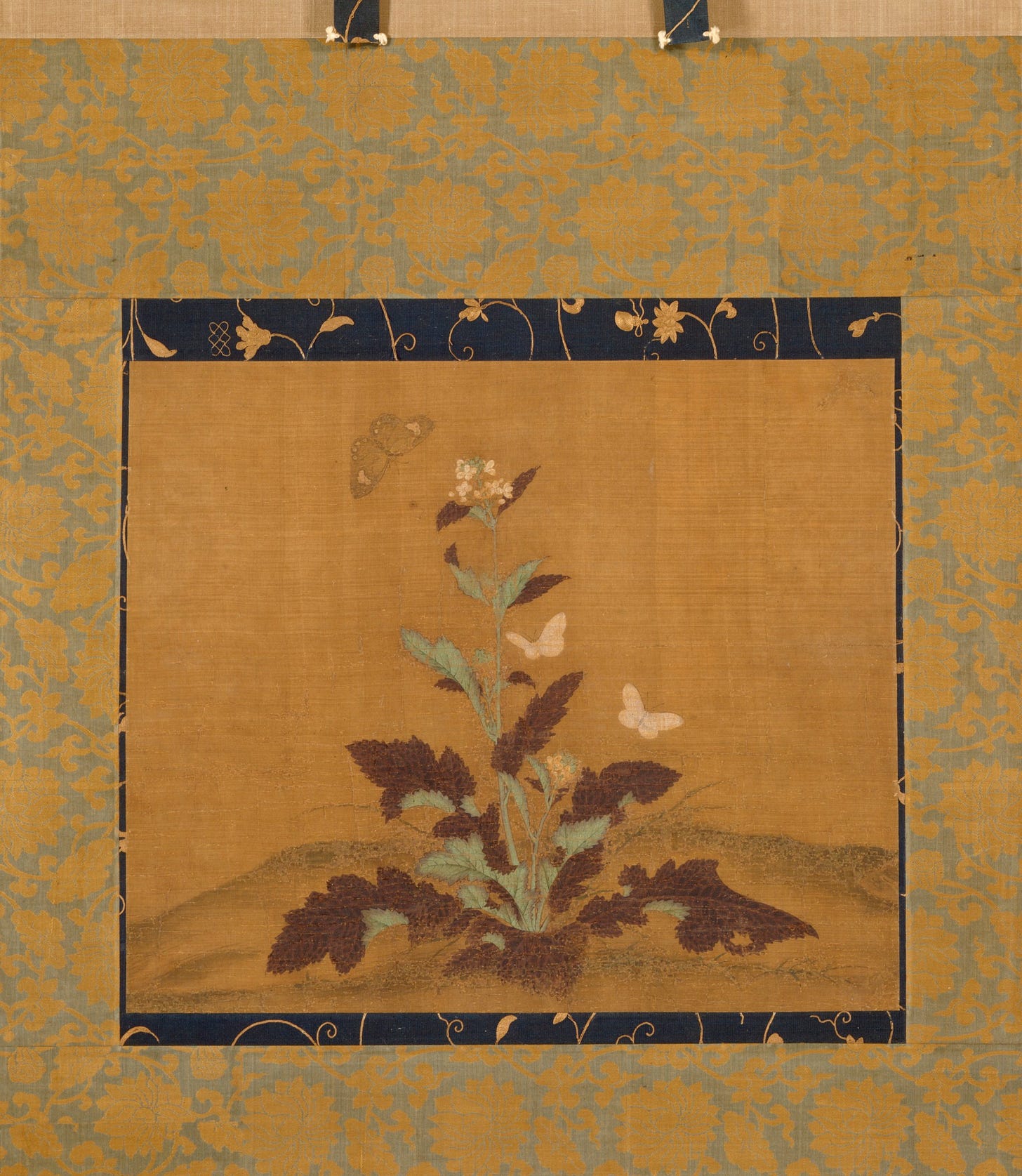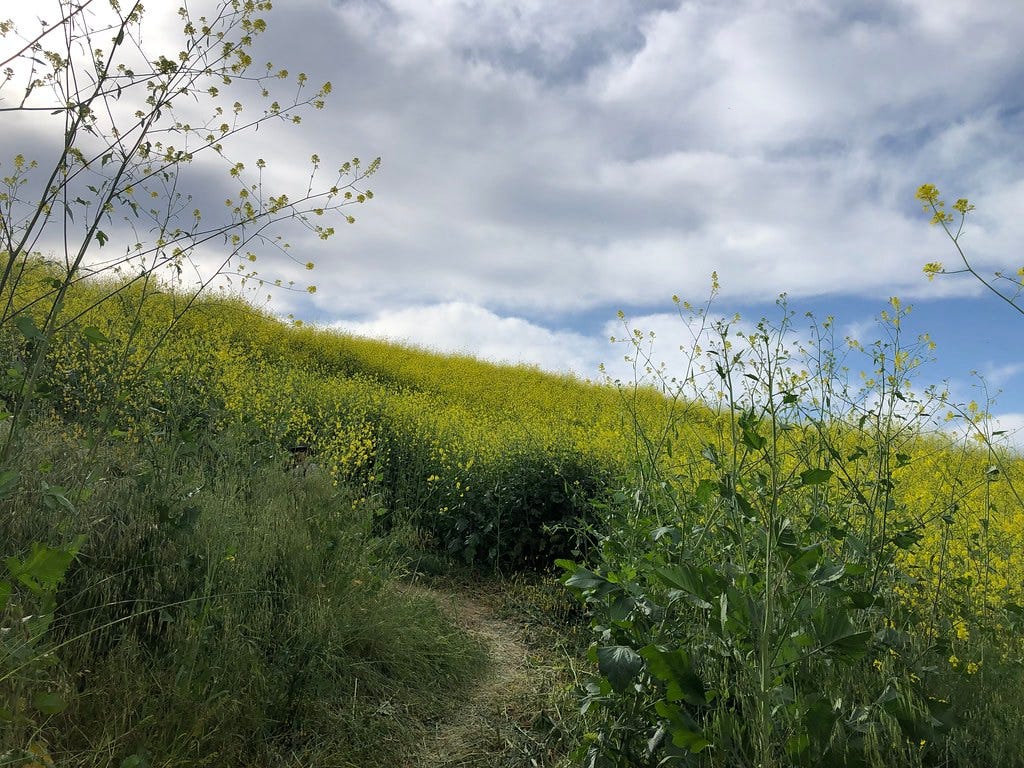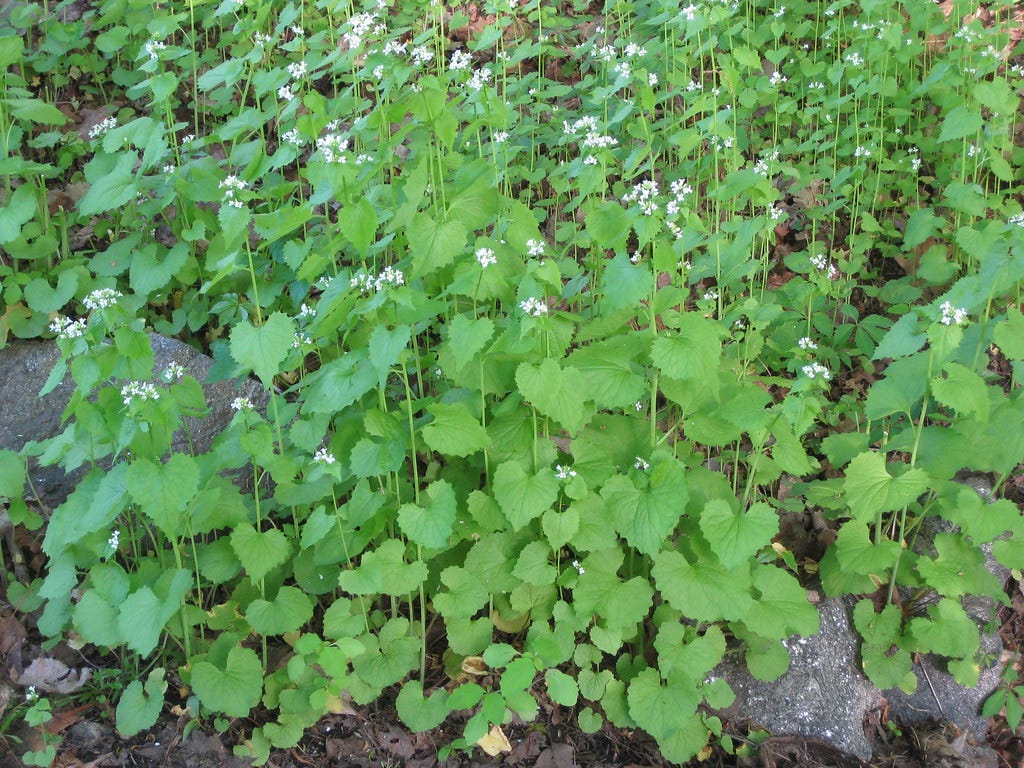ALSO KNOWN AS: True mustard, red mustard, Brassica nigra, mostaza, shortpod mustard
how to know
ladle basal leaves opposite one another
tall stems
topped with small racemes of flowers
these flowers are always yellow
and the petals make a cross
oblong seedpods that sometimes pop
My partner and I drove to Glacier National Park where the mustard fields inspire ecstasy. Here we drove through expanses of chartreuse covered with a soft cloud of yellow. Behind these illuminated seas rose mountains so majestic they appeared to be a deity. The mountains of Glacier are the mountains of mountains. In the way of gods, they are the super real. And below them, glowing in a warm July sun, are the fields of Brassicaceae that flicker like ambrosia. I cried, then, looking at the fields from the car window. This mustard circles the holiest of mountains: adorning the tallest of places where the earth becomes the sky.
As Valuable as Gold As Common as Dirt
Mustards are part of the Brassicaceae family which includes a wide range of plants that have been cultivated for thousands of years. The oldest records about mustard occur around 6,000 years ago independently in central China and Europe. It is also found in ancient Indian and Sumerian texts. It was found in the sacking of Tutankhamen’s grave. Pythagoras used it for scorpion stings. Hippocrates wrote about mustard as a treatment for ailments of the lungs. Mustard was a medicine before it was a food. But there is little written about it. It seems to have grown everywhere, so common it doesn’t make traction in literature or inspire romance. But as a plant, it acts like a Georgian era beau. The mustard adapted alone on the Mediterranean’s inhospitable limestone cliffs in North Africa, pushing everything else away and swaying in the wind; enjoying the cold. Despite its early hermitage, the mustard now grows throughout the temperate regions of the globe. But it still pushes other plants away.
Mustards are part of the cabbage family. Yes, they are related to brussels sprouts, and bok choy, turnip, broccoli, and kale. In all, there are 3,700 species of Brassicaceae all over the world, except for Antarctica and several tropical locations like in Brazil, the Congo Basin, and the Southeast Asian archipelagoes. There are 40 species of mustard, many of which are natural hybrids of Brassica species. Black mustard is the wild kind, and the base of the white and brown mustards, which are the common hybrids.
Yellow, brown and black are the three main species of mustard that have all been bred as a result of the cross between the black mustard and the brassica rapa - the big yellow bear of the Brassica family, which is also the unassuming turnip. Black mustard is not cultivated widely because it is not conducive to mechanized farming. Their seed pods tend to burst when they are ready, distributing tiny dark balls over the ground, away from machines and from the hands of pickers.
Some of the rare symbolic literature about mustard comes about in Semitic texts. Famously, Jesus gives a parable about the seed: that all of faith exists within a vessel as small as the mustard seed. And if cultivated, it can do seemingly impossible things, the way the mustard seed, he describes, will grow big enough to hold an ecosystem - a tree, as it is translated. The mustard can grow quite tall, but not as tall as a tree.
Mustard grows in full sun with moist soil. They bloom late in the summer. Their stalks are narrow and reach up to about 5-6.5’. Each fruit pod ripens around August and can hold dozens of seeds, producing thousands in one season alone. They’re so resilient they’re weeds in the US midwest, and south into Mexico. They grow in many types of soil and don’t get many pests. As a maniacal weed, mustard can wreak havoc to an existing ecosystem. They have allelopathic properties, meaning they release chemicals into the soil that make it inhospitable to native plants by killing the bacteria these plants need to grow. The mustard can even be ground into a powder to deter unwanted plants and animals to the garden plot. This can be useful to gardeners who are looking for a companion crop to get rid of plant pests and other weeds, but it makes the mustard an aggressive species untethered. Sometimes the effects of mustard in the soil can last for years.
In California the mustard plants - including black mustard - can become highly flammable, drying out and releasing from their roots where they whirr free and everywhere like tumbleweeds. Yet, black mustard, along with all of the mustard plants, have the capacity to draw heavy metals out of the soil, thus they can be used for soil remediation.
The entire Brassicaceae family is plastic, they can look very different depending on the climate and environmental conditions where they grow. Mustard can develop complex root systems, holding the ground in place and growing vegetatively through rhizomes.
The flowers are always yellow with four delicate petals opposite one another in a cross formation, a form that gave Brassica its first name: Cruciferae. These petals grow like the finest sheets, seeming to be separating off of the plant, peeling down the sides of the sepal. Two of the petals grow only very early in the summer. They are shallow spurs, yet they often fall before they have time to be seen. The mustard flower is bisexual and full of both pollen and nectar that attracts honey bees. The flowers can self pollinate too, so the mountain and field winds are another form of pollination for this plant.
The seeds of black mustard are a dark auburn shade. They, themselves contain between 30% and 40% vegetable oil, a little less protein, and the enzyme myrosin. For this reason, plants in the mustard family are used for oils, such as canola oil, that comes from the same wild descendant of mustard, Brassica rapa. Mustard is high in Omega 3 fatty acids. All Brassica plants have glucosides, but the mustards are famous for them. The glucosides in black mustard become myrosin, which brings that fierce bite to the taste.
In the mild and brackish food of the Europeans in the middle ages, the mustard, along with horseradish, was the first plant that was used as a spice - or a cover for rancid meat.
It was a delicacy in Rome. But for how aggressively mustard grows, it was just as easily a plant used by peasants. Indeed, there was a French boom of mustard in the mid-to-late 1700’s in the south of France when Maille, Grey and Poupon, and other French makers refined spicy mustard condiments making that staple Dijon mustard flavor. Though this brilliant condiment lost popularity as extraction in the global south brought more “exotic” spices north as a result of colonization.
The Chemistry of a Mustard Bite
Mustard never quite lost its charm, though. Mustards are an acquired taste, but for some meals they play an important chemical function. Mustard’s acidity has the distinct culinary effect of breaking down even the oiliest and fattiest of dishes. For this reason it is eaten with hotdogs and, or on fried foods, or simply breaking through the rich starch of potato. The stronger mustards like Dijon, and other French mustards come from the black or brown mustard species, which is stronger than the white mustard, commonly used in German and American dishes. Currently mustard is grown commercially in the plains of western Canada, the US Great Plains, Nepal, Hungary, and Britain.
When mustard seeds are ground or dried you can’t smell them. Most plants give off their oil at the touch. These seeds must be tasted - and then the lightning comes. The taste is not immediate. The mustard comes through first in a rounded, nutty flavor in the mouth. The enzyme myrosin, merges with the saliva to activate the glucosinolates into an isothiocyanate and igniting the mustard taste. The level of spice depends on the mustard. Black mustard are the strongest, thus the brown, and white mustard plants yield a respective lowering of intensity.
When mixed with water an enzyme and a glucoside come together to make an oil that hadn’t previously existed in the plant before, thus, in black mustard, volatile oil is born, the oil that heats your nose and lacerates the tongue: the mustard taste we know so well.
The leaf stems can be harvested when they’re soft and new, only three weeks open, up until the time they flower or bolt. The seeds are harvested when they rattle in their brittle vessels in October.
The residual seed after making oil - called the cake - can be used to feed some livestock. Though pigs, for example, are very sensitive to mustard - as many animals are. In addition to mustard oil, the seeds can be ground and made into flour. The volatile bitterness is lessened when the mustard seeds are heated. So it won’t taste like pure mustard cookies.
Mustard is above all, a medicine. It has counterirritant properties, so it is used to remedy chest colds. It is also used as a diuretic and a stimulant. The minerals it contains are manganese, iron, magnesium, and selenium, a rich concoction that aids in anti-inflammatory response and an anti-cancer agency. Being one of the oldest plants in cultivated history, a plant humans have embraced fully, a plant that gives in so many ways as inspiration, wellness, and beauty mustard is rarely seen for all that it is. Among the greatest mountains, an ancient tradition of mustard continues, as infants in Nepal are massaged with mustard oil to warm and stimulate them, differentiate them and welcome them to the world. The mustard must teach, as it sits there on the skin, about boundaries, and the way it makes space for itself, the way it gives. It must teach about travel and adaptation. As the sun goes down below the mountains, it must teach about the value of glowing with a persistent and subtle light.
myth for black mustard
Not to be confused with rapini, which has similarly shaped leaves. But the buds of rapini are more fleshy and there are many more flowers on each raceme.
Garlic mustard, these plants have white flowers. Their leaves are more hearshaped than the mustard plant. They both share siliques, or very narrow seed pods.
Forager Friendly?
Yes, make sure you are harvesting responsibly and you understand the laws around its invasive requirements and status where you live. But use it!
Sources
https://www.indefenseofplants.com/blog/2018/5/1/one-mustard-many-flavors
https://www.britannica.com/plant/brown-mustard
https://hyg.ipm.illinois.edu/article.php?id=1291
https://en.wikipedia.org/wiki/Brassicaceae
https://www.thenibble.com/reviews/main/condiments/history-of-mustard1.asp
https://ruminations.ca/2016/02/19/mustard-from-prehistoric-pot-to-ballpark-dog/
https://hekint.org/2020/02/18/mustard-history-of-the-yellow-seed/
https://plantura.garden/uk/vegetables/mustard-plant/mustard-plant-overview
Parable of the mustard seed by Caswell, Helen Rayburn 1992
https://treepeople.org/2024/06/11/black-mustard/
https://www.mdpi.com/2304-8158/10/9/2089
https://plants.ces.ncsu.edu/plants/brassica-nigra/
https://awkwardbotany.com/tag/mustard-seeds/







